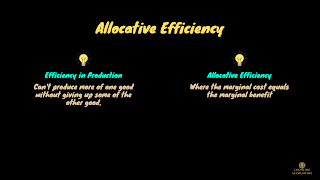In this article, we're going to discuss the concept of Allocative Efficiency. When we look at a production possibilities frontier let's say for food and for clothing, we know that every point along the PPF is efficient in production, and what we mean by efficient production is that at any point so let's say at the point with three units of food and four units of clothing so (3, 4) at that point, we cannot produce more of one good. for example food, we can't produce additional food without giving some of the other goods. So we can't produce at point (3, 4) because we couldn't go to four units of food without giving up some clothing. We're using our resources to the maximum to get this we could get more food but we'd have to give up some clothing.
Okay, so all these points along the curve are efficient in production but which one which point is going to be the one that we end up as best for society? Well, that gets into the idea of allocative efficiency. Allocative efficiency is saying that the goods produced correspond to those that are actually desired by individuals. Think about a crazy example, think about a society where you have a factory that only produces left shoes right and so we might say here we're efficient in production and so forth but do people want a society where we only have left shoes? No, we want left and right shoes. We want a pair of shoes. So the goods that are produced have to correspond to those that are desired by individuals.
We can find that using calculus and we can do things like we can talk about where we have an indifference curve and we see the point where the indifference curve is tangent to the PPF. If there's the indifference curve is tangent to the PPF that's the point of Allocative efficiency but another way we can do it without using any math or anything like that is we can look at the marginal cost curve which we can derive from the production possibilities frontier. We can look at the marginal benefit curve which cannot be derived from the PPF but if you have the data if you have information about people's willingness to pay you can use the marginal benefit curve in the marginal cost curve to find the point where the marginal cost equals the marginal benefit which is going to be the point of allocative efficiency.
I want to show you how we would superimpose the marginal cost curve on the marginal benefit curve. We've got in a previous article where we mapped out the marginal cost using the numbers just from the PPF and so forth. So we've got our marginal cost curve and it's increasing and that explains the bowed-out shape of the PPF, resources are not equally productive. Now we also have our marginal benefit curve, a decreasing marginal benefit curve. why? As people like variety. As they get more and more of one good they start to value the other good more. So you get tons and tons of food and you start to say I'm not getting as much benefit from food is when I had no food and you gave me the first piece of food that's when you get the most benefit right so we've got this decreasing marginal benefit and the increasing marginal cost curve and we want to know where is the point of allocative efficiency. What is the amount of food and clothing that everyone would be best of? What would be the efficient amount?
So what we can do is we can take the marginal cost curve and we can map it onto this marginal benefit curve. So ok that y-axis is a marginal benefit but let's say it's the marginal cost or marginal benefit or you could just put a dollar sign. However, you want to think about it but I'm just going to keep the marginal benefit curve here but then also I'm going to draw this marginal cost curve. We can just use the data from the marginal cost curve and try to graph it into our marginal benefit curve. So when we have zero food the marginal cost is one. So that would put us right at point (0. For one food the marginal cost would be two. For two food the marginal cost is three and then we have three food the marginal cost would be four.
So that's going to correspond to this point right here all right now I'm just going to put a little line through this. You can see so now this is our marginal cost curve so it's a marginal cost curve and we've got our marginal benefit curve. Now you notice that the point right in the middle intersects, that point is two food, this is going to be the point of allocative efficiency. So remember that we've got two pieces of food, in the PPF two pieces of food corresponds to seven pieces of clothing. So this is going to be the point this is the bundle of goods we want to produce. (3, 4) is also efficient in production but it's not allocative efficient. This is the most preferred bundle.
Remember the PPF is just a bunch of different combinations of goods that the society hypothetically could produce. Of all these combinations this (2, 7) is the combination that people want the most and so this is not only efficient in production it's also allocative efficient. So society would be best off if we produce two units of food and seven units of clothing and if we were to draw an indifference curve it would be tangent to our PPF right here at the point of allocated efficiency.







